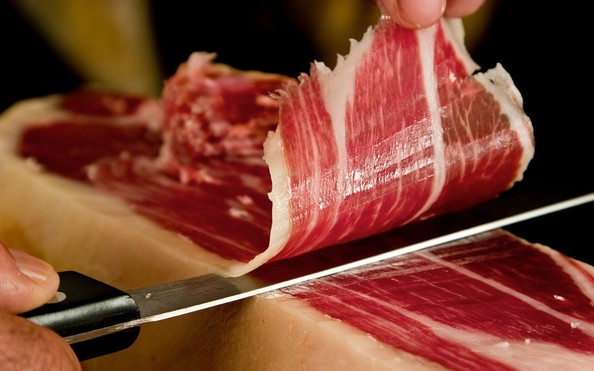
Jamón Ibérico, often hailed as the world’s most expensive cured meat, is more than just a culinary delicacy; it’s an embodiment of Spanish tradition, a testament to the intimate relationship between nature and gastronomy. This exquisite ham, with its rich marbling, buttery texture, and complex, nutty flavor, is a true testament to the dedication of Spanish artisans who have perfected its production over centuries.
But what exactly elevates Jamón Ibérico to such lofty heights? Let’s embark on a journey to uncover the secrets behind this prized delicacy, exploring its origins, production process, and the factors that contribute to its luxurious price tag.
The Iberian Pig: A Breed Apart
Our journey begins with the star of the show: the Iberian pig, a breed indigenous to the Iberian Peninsula, encompassing Spain and Portugal. These remarkable animals, known for their black hooves and remarkable ability to store fat intramuscularly, are the sole source of authentic Jamón Ibérico.
Unlike their commercially raised counterparts, Iberian pigs destined for producing top-tier Jamón Ibérico lead a life of freedom and indulgence. They roam freely in vast, oak-studded pastures called dehesas, feasting on a diet of acorns, herbs, and grasses. This free-range lifestyle, coupled with their unique genetics, contributes significantly to the ham’s exceptional quality.

The Acorn Connection: Nature’s Gift to Flavor
The acorn, or bellota in Spanish, holds a place of honor in the world of Jamón Ibérico. During the montanera season, which spans from October to March, Iberian pigs gorge themselves on these fallen acorns, rich in oleic acid and antioxidants. This acorn-rich diet imparts the ham with its characteristic nutty, slightly sweet flavor and contributes to its melt-in-your-mouth texture.

The Art of Curing: A Labor of Love and Time
The transformation of a pig’s leg into the prized Jamón Ibérico is a meticulous process that demands patience, skill, and an unwavering commitment to tradition.
Salting and Curing: The process begins with salting the hams, which draws out moisture and initiates the curing process. The hams are then hung to dry in carefully controlled environments, where temperature and humidity are meticulously monitored.
Post-Salting Rest: After several weeks, the salt is rinsed off, and the hams enter a period of “post-salting rest,” allowing the salt to distribute evenly throughout the meat.
Drying and Aging: The hams are then transferred to drying sheds, where they hang for months, even years, absorbing the flavors of the environment. This slow, natural drying process is crucial for developing the ham’s characteristic depth of flavor and aroma.
Cellaring: The final stage involves moving the hams to cellars for further aging, where they develop their signature complex bouquet. Expert “maestros jamoneros” use their refined senses to determine when a ham reaches its peak of perfection.

Decoding the Labels: A Guide to Jamón Ibérico Classifications
Navigating the world of Jamón Ibérico can be daunting, especially with its various classifications. Here’s a breakdown to help you decipher the labels:
| Label Color | Designation | Pig Breed | Diet |
|---|---|---|---|
| Black | Jamón Ibérico de Bellota 100% Ibérico | 100% Iberian | Exclusively acorns and natural pastures |
| Red | Jamón Ibérico de Bellota | 50-75% Iberian | Acorns and natural pastures |
| Green | Jamón Ibérico Cebo de Campo | 50-75% Iberian | Acorns, pastures, and feed |
| White | Jamón Ibérico de Cebo | 50-75% Iberian | Primarily feed |
As you move up the label hierarchy, the price increases, reflecting the pig’s breed purity, diet, and the duration of the curing process. The black label Jamón Ibérico de Bellota 100% Ibérico, often referred to as “pata negra” (black hoof), reigns supreme, representing the pinnacle of quality and flavor.

Savoring the Experience: A Culinary Revelation
The true magic of Jamón Ibérico unfolds when you savor its delicate, melt-in-your-mouth texture and complex, nuanced flavors. The best way to enjoy it is thinly sliced, preferably by hand, and served at room temperature. The fat, glistening like marble, should be enjoyed along with the meat, as it contributes significantly to the ham’s flavor profile.
Pair your Jamón Ibérico with crusty bread, a glass of Spanish red wine like Rioja or Ribera del Duero, or even a crisp, dry sherry for a truly authentic experience.

Beyond the Price Tag: An Investment in Culinary Heritage
While the price of Jamón Ibérico might seem intimidating, it’s essential to recognize that you’re not just paying for a culinary experience; you’re investing in centuries of tradition, meticulous craftsmanship, and an unwavering dedication to quality.
For those seeking an unparalleled gastronomic adventure, Jamón Ibérico is more than just a delicacy; it’s a revelation, a testament to the artistry of Spanish cuisine and the intimate relationship between nature and gastronomy.
Further Exploration:
- D’Artagnan: A reputable source for high-quality Jamón Ibérico and other gourmet foods.
- La Tienda: Offers a wide selection of Spanish food products, including various grades of Jamón Ibérico.
- Foods of Spain: A comprehensive resource for exploring Spanish cuisine and culinary traditions.






